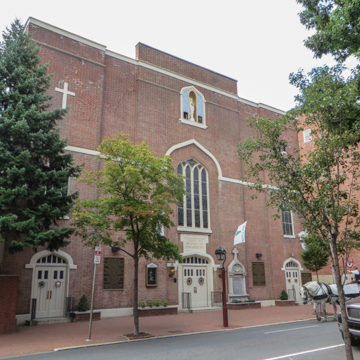By virtue of its site on a principal street, St. Mary's quickly became the more fashionable of the two early Catholic churches of the city (St. Joseph's was the other; PH27). Its location on the west side of the block originally resulted in the placement of the altar at the street end like Christ Church (PH4), but this was reversed in 1880. From 1808, when the Philadelphia diocese was separated from Baltimore, until 1838, St. Mary's was the cathedral church of the city. The Thomas Ustick Walter–designed organ case (1839), with its simple pilasters, and the crucifix by William Rush, the first American sculptor of note, add interest to the interior. The exterior is a severe exercise in the Gothick, perhaps inspired by Benjamin Henry Latrobe's Philadelphia Bank (1807; demolished). The interior by contrast was an exercise in gilding and color that prompted John Adams to exclaim in his diary, “the scenery and the music are so calculated to take in mankind, that I would wonder the Reformation ever succeeded.” In the graveyard are buried such leaders as Commodore John Barry and neighbor Michael Bouvier.
You are here
St. Mary's Roman Catholic Church
1763; 1810–1812 rebuilt, Charles Johnson, master carpenter; 1880, reorientation of church and west apse. 252 S. 4th St.
If SAH Archipedia has been useful to you, please consider supporting it.
SAH Archipedia tells the story of the United States through its buildings, landscapes, and cities. This freely available resource empowers the public with authoritative knowledge that deepens their understanding and appreciation of the built environment. But the Society of Architectural Historians, which created SAH Archipedia with University of Virginia Press, needs your support to maintain the high-caliber research, writing, photography, cartography, editing, design, and programming that make SAH Archipedia a trusted online resource available to all who value the history of place, heritage tourism, and learning.















